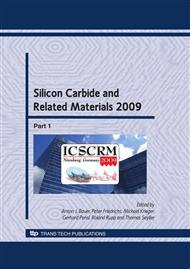p.1147
p.1151
p.1155
p.1159
p.1163
p.1167
p.1171
p.1177
p.1183
Mixed Mode Modeling and Characterization of a 4H-SiC Power DMOSFET Based DC-DC Power Converter
Abstract:
We present detailed mixed-mode simulations of a DC-DC converter based on 4H-SiC DMOSFETs. The mixed-mode modeling enables the use of complex physics based models for the interface trap occupation and surface mobility that are typical for 4H-SiC devices, and apply them to a practical circuit application such as a DC-DC boost converter. The mixed mode simulations are performed for a reduced DC-DC converter circuit to evaluate the performance of the DMOSFET when it has an inductive load. The current inside the device and its power dissipation during switching are evaluated numerically. Further, the mixed-mode device simulation shows that the majority carriers (electrons) inside the 4H-SiC DMOSFET require a finite time to go from the ON (strongly inverted) to the OFF (depleted) state, thereby causing power dissipation and heating during the turn-off period. The peak power is dissipated in the JFET region of the device which indicates that maximum heat and therefore maximum temperature may be generated there.
Info:
Periodical:
Pages:
1163-1166
Citation:
Online since:
April 2010
Authors:
Price:
Сopyright:
© 2010 Trans Tech Publications Ltd. All Rights Reserved
Share:
Citation:


